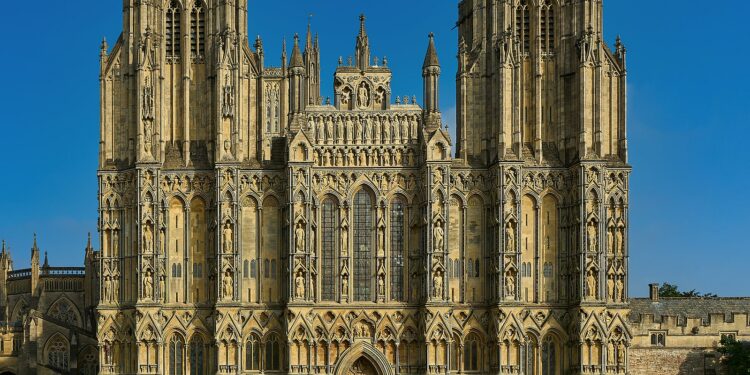Pisa’s original cathedral dome was supported on Islamic-style squinches and slender pointed-arch windows, while the engineering challenges of the tower would have required advanced geometrical knowledge – the famous lean is the result of subsidence, not faulty construction.
Advanced geometrical knowledge
More proof of Arab involvement in churchbuilding comes in the Arabic numerals, with their distinctive cursive shapes, carved as assembly marks, found by chance in the roof timbers at Salisbury Cathedral (1220s) during a dendrochronology study sponsored by English Heritage. They were also an accidental find, carved as position markers on the stone sculptures, on the famous Wells Cathedral West Front (1175).
Since English craftsmen at that time could only manage the simple straight lines of Roman numerals, and Arabic numerals did not enter general use in Britain till several centuries later in the 1500s, the carpenters and masons employing them as early as the 12th and 13th centuries were clearly highly educated foreigners, brought in by wealthy bishops and abbots keen to sponsor the absolute top level of construction money could buy.
!['Cursive freehand Arabic numerals (4 and 5) carved as assembly markers by the original carpenters in the roof timbers of West Court Farm, a manor house in Wiltshire, England. The numerals were dated by dendrochronology to 1316, two centuries before Arabic numerals were in common use in England.' [photo by Diana Darke taken 6 June 2019].](https://www.bing.com/sites/default/files/Arabic%20numerals%204%20and%205%20West%20Court%20Farm%20Oct%202022%20%281%29%282%29.jpg)
Cursive freehand Arabic numerals (4 and 5) carved by the original carpenters in the roof timbers of West Court Farm in Wiltshire, England dated to 1316. [photo by Diana Darke taken 6 June 2019]
At Wells Cathedral, construction was halted when the funds allocated for the building were diverted, following the death of the bishop, to pay the huge litigation costs between rival claimants to his bishopric of a court case in Rome at the papal curia.
The masons, no longer being paid, simply marked up their final sculptures with Arabic numbers to indicate their correct niches on the West Front, then moved on to their next commission.
When the dispute was finally resolved 15 years later, local masons were the only ones on the scene to erect the sculptures.
To them, the Arabic symbols were just incomprehensible hieroglyphs, so they put them in the wrong niches, even adjusting the niches to make them fit.
Researchers in the most recent restoration have now established that, had the sculptures been put back in accordance with their original Arabic sequencing, they would have fitted perfectly.
Sophisticated society
The masons’ marks on display on the back wall of the Cordoba Mezquita are overwhelmingly Arab names written in Arabic script, showing how the 10th-century craftsmen were literate centuries ahead of their European Christian counterparts.
They were the products of a sophisticated society where learning was encouraged by the ruler and enjoyed by all, thanks to free education offered by mosque schools. In Christian Europe, only the clergy and a handful of the upper classes could read and write.

Cursive masons’ marks from the 10th century extension of the Cordoba Mezquita, found during restoration, now on display near the mihrab. [photo by Diana Darke taken October 2022]
Names in themselves can be misleading. In the town of Corleone, for example, inland from Palermo, there were Christians called Muhammad, Abdullah, Ahmad and Ali, living alongside Muslims with Greek names, who could pass for Sicilian Christians.
Donation records in Greek during the Norman period in Sicily use phrases like “Roger who was once called Ahmad”, showing how local Muslims adapted their names to fit in better to the new environment and new masters, just as foreign workers arriving in Britain today might adapt their names or be given nicknames that are easier to remember and pronounce. Jews have done the same thing across Europe and America for centuries.
When the names of craftsmen first started to appear in the Latin chronicles, like William of Sens, thought to have worked on Notre-Dame, and much vaunted for introducing six-part rib vaulting to England at Canterbury Cathedral in 1174-77, we cannot assume he was Christian. He might have been Muslim, or Mozarab (an Arabised Christian).
Either way, in order to have had the requisite mathematical and geometrical knowledge for rib vaulting at that time, he must have been schooled in the Islamic tradition.
Great pride
At the recent Notre-Dame rebuilding, a traditional carpentry company called Atelier de la Grande Oye, founded by French Muslim Paul Zahnd, was among those chosen to build the wooden frames supporting the new roof.
In an email to me, he expressed great pride at this honour, a pride likely to have been felt in equal measure by the top Muslim craftsmen working on Christian buildings in medieval times.
“As French Muslims,” he wrote, “we are very proud and happy … to communicate our beautiful crafts and our faith, which are of course perfectly compatible, feeding one another … we prayed all along the work, to bless the trees, our craft, our friendship, the Almighty who allowed us to be part of the project, to bless all the people who work with us, to celebrate the beauty and majesty of our creator … some of us are affirmed Muslims claiming our faith and our joy to rebuild a cathedral.”

This aerial picture, taken on 22 November 2024, shows Notre-Dame de Paris Cathedral being readied for its grand reopening (Damien Meyer/AFP)
What an irony that across Europe, at the time of writing, there are increasingly loud calls from far-right parties to rid their country of immigrants, especially Muslims, in order to save the “purity” of their own race and culture, evidently unaware that their very civilisation was built on the superior skill of immigrants.
All the evidence has shown that it is not necessary to be a Christian in order to create Christian art, just as people of all faiths and none can enjoy and appreciate church music, church architecture, Islamic decorative styles and mosque architecture.
Muslims could put their expertise to use in churches, just as Christians could build mosques, and indeed have done, throughout history.
The important consideration was not their religion but their skill.
Diana Darke’s new book Islamesque: The Forgotten Craftsmen Who Built Europe’s Medieval Monuments, was published on 21 November 2024, as a sister volume to her earlier Stealing from the Saracens (2020).
The views expressed in this article belong to the author and do not necessarily reflect the editorial policy of Middle East Eye.
Source link : http://www.bing.com/news/apiclick.aspx?ref=FexRss&aid=&tid=674a13f452a24979b3c7741b4366e805&url=https%3A%2F%2Fwww.middleeasteye.net%2Fopinion%2Feurope-great-cathedrals-owe-much-muslim-craftsmen&c=13240784355523597818&mkt=de-de
Author :
Publish date : 2024-11-29 08:40:00
Copyright for syndicated content belongs to the linked Source.



